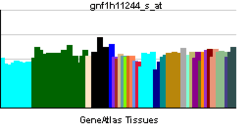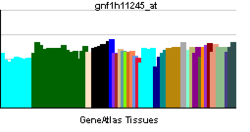OR10G2
| Olfactory receptor, family 10, subfamily G, member 2 | |||||||||||||
|---|---|---|---|---|---|---|---|---|---|---|---|---|---|
| Identifiers | |||||||||||||
| Symbols | OR10G2 ; OR14-41 | ||||||||||||
| External IDs | MGI: 3031345 HomoloGene: 87788 GeneCards: OR10G2 Gene | ||||||||||||
| |||||||||||||
| RNA expression pattern | |||||||||||||
 | |||||||||||||
 | |||||||||||||
| More reference expression data | |||||||||||||
| Orthologs | |||||||||||||
| Species | Human | Mouse | |||||||||||
| Entrez | 26534 | 258268 | |||||||||||
| Ensembl | ENSG00000255582 | ENSMUSG00000063867 | |||||||||||
| UniProt | Q8NGC3 | A4FU93 | |||||||||||
| RefSeq (mRNA) | NM_001005466 | NM_146271 | |||||||||||
| RefSeq (protein) | NP_001005466 | NP_666383 | |||||||||||
| Location (UCSC) |
Chr 14: 21.63 – 21.63 Mb |
Chr 14: 52.39 – 52.39 Mb | |||||||||||
| PubMed search | |||||||||||||
Olfactory receptor 10G2 is a protein that in humans is encoded by the OR10G2 gene.[1][2]
Olfactory receptors interact with odorant molecules in the nose, to initiate a neuronal response that triggers the perception of a smell. The olfactory receptor proteins are members of a large family of G-protein-coupled receptors (GPCR) arising from single coding-exon genes. Olfactory receptors share a 7-transmembrane domain structure with many neurotransmitter and hormone receptors and are responsible for the recognition and G protein-mediated transduction of odorant signals. The olfactory receptor gene family is the largest in the genome. The nomenclature assigned to the olfactory receptor genes and proteins for this organism is independent of other organisms.[2]
See also
References
- ↑ Koop BF, Rowen L, Wang K, Kuo CL, Seto D, Lenstra JA, Howard S, Shan W, Deshpande P, Hood L (Jun 1994). "The human T-cell receptor TCRAC/TCRDC (C alpha/C delta) region: organization, sequence, and evolution of 97.6 kb of DNA". Genomics 19 (3): 478–93. doi:10.1006/geno.1994.1097. PMID 8188290.
- 1 2 "Entrez Gene: OR10G2 olfactory receptor, family 10, subfamily G, member 2".
Further reading
- Boysen C, Simon MI, Hood L (1997). "Analysis of the 1.1-Mb human alpha/delta T-cell receptor locus with bacterial artificial chromosome clones". Genome Res. 7 (4): 330–8. doi:10.1101/gr.7.4.330. PMID 9110172.
- Malnic B, Godfrey PA, Buck LB (2004). "The human olfactory receptor gene family". Proc. Natl. Acad. Sci. U.S.A. 101 (8): 2584–9. doi:10.1073/pnas.0307882100. PMC 356993. PMID 14983052.
External links
- OR10G2 protein, human at the US National Library of Medicine Medical Subject Headings (MeSH)
This article incorporates text from the United States National Library of Medicine, which is in the public domain.
| ||||||||||||||||||||||||||||||||||||||||||||||||||||||||||||||||||||||